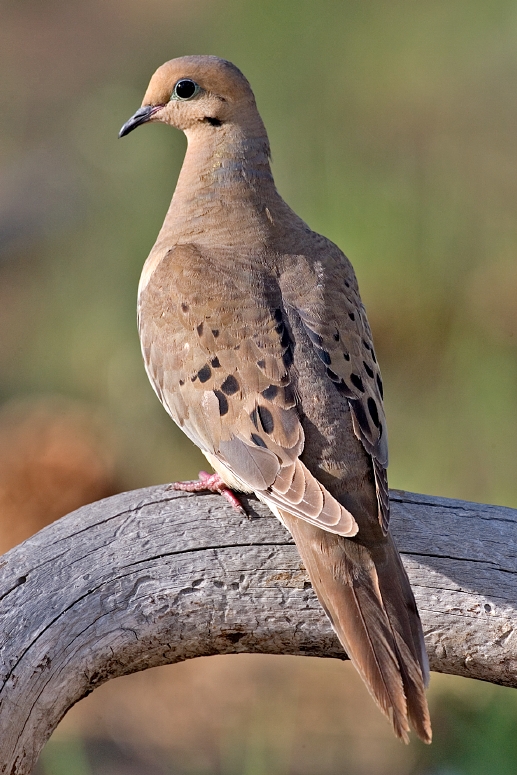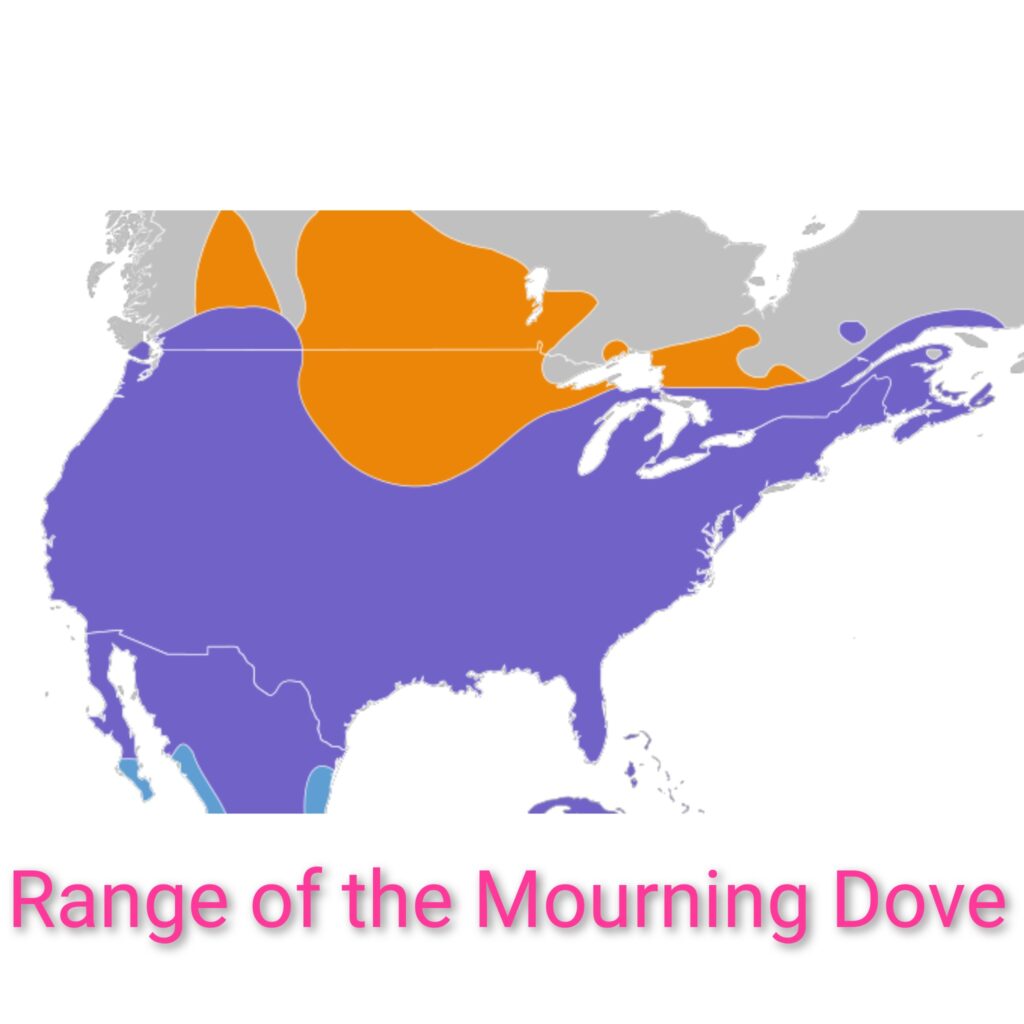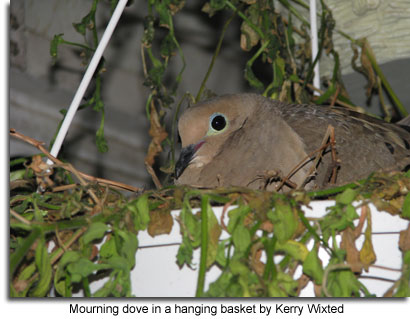Celebrating the Bird of Peace and Hope
The very first bird I was able to identify as a young child was none other than Zenaida macroura — the mourning dove. Of course, way back then I thought it was “morning” dove since that’s the time of day when I could see and hear them outside my window. I just love these beautiful, graceful and peaceful birds. I hope you will, too.
Along with pigeons, this bird belongs to the family Columbidae, and is also known as the American mourning dove, the rain dove, and colloquially as the turtle dove. It was also once known as the Carolina pigeon and the Carolina turtledove, but these have fallen out of use over time.
Easily recognized by its slender body, long pointed tail, gray-brown plumage, black spots on the wings, and a black mark behind the eye, the mourning dove is named for its distinctive cooing call, which sounds like a lament or a sigh.
Geographic Range
The mourning dove can be found from southern Canada to central Mexico, and from the Atlantic to the Pacific coast. With a population of more than 400 million, the mourning dove is one of the most numerous and widespread birds in North America. In fact, today the mourning dove is the only native North American bird that builds its nests and raises its chicks in all 50 states — including Hawaii.
Mating, Nesting and Breeding
Prolific breeders, mourning doves are generally monogamous and will form life-long pair bonds. The male’s elaborate courtship ritual includes a flight display in which he flies up with noisy wingbeats and then glides down in a circle, with his wings spread and slightly bowed.
Once on the ground, the male approaches the female with his chest puffed out, bowing and cooing. If the female is sufficiently impressed, she will shortly thereafter be about the business of choosing the nesting site, which is usually in a tree or shrub, and sometimes on the ground.
The male typically gathers twigs, conifer needles or grass blades and presents them to the female, who uses them to build a nest. Clutch size is two eggs and incubation period is two weeks. Both parents sit on the eggs, the male from morning to afternoon and the female the rest of the day and at night. Fledging occurs after about 15 days, after which the baby doves — or squabs — will hang around for a couple more weeks to be fed by the parents. In warmer parts of their range, mourning doves may raise as many as six broods in a season — the most of any native bird.
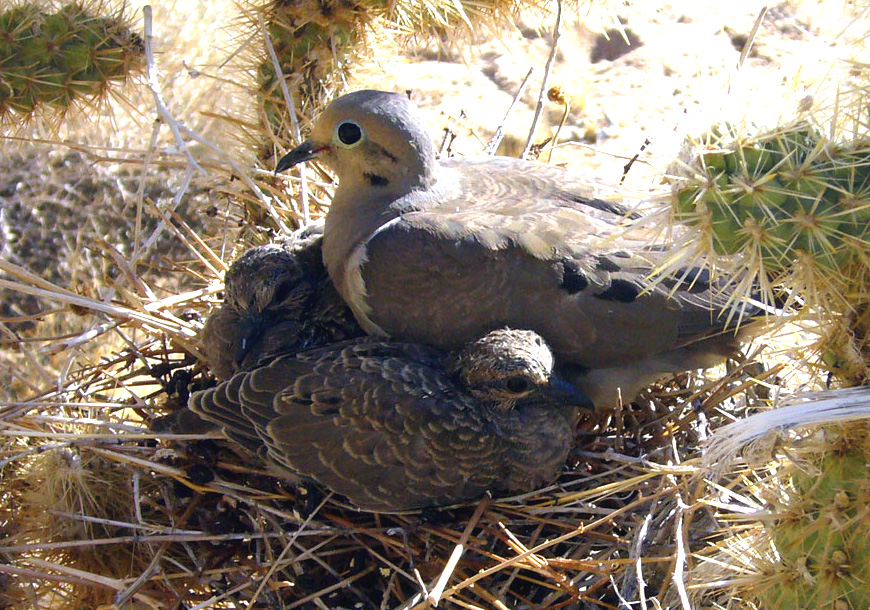
Photo by Jessie Eastland – Own work, CC BY-SA 3.0,
https://commons.wikimedia.org/w/index.php?curid=18287238
Migration
The mourning dove is a partial migrant, meaning that some populations are resident year-round, while others migrate south for the winter. They fly mostly by day, in large flocks and at low altitudes. Migration patterns are influenced by several factors, like food availability, weather and day length. Mourning doves can fly at speeds of up to 55 mph and can cover distances of up to 500 miles in a single day.
Eating and Drinking
Mourning doves are granivorous birds, meaning they feed mostly on seeds. Typical fare includes seeds of grasses and weeds, grains, and cultivated crops like corn, wheat, millet and sunflower. They will also eat some fruits, berries and insects, especially during the breeding season. Mourning doves forage on the ground — often in groups of 20 or more — where they peck incessantly at seeds. They eat roughly 15 to 20 percent of their body weight per day — which would be like me consuming 30 pounds of food daily. That’s a lot of cheese burgers!
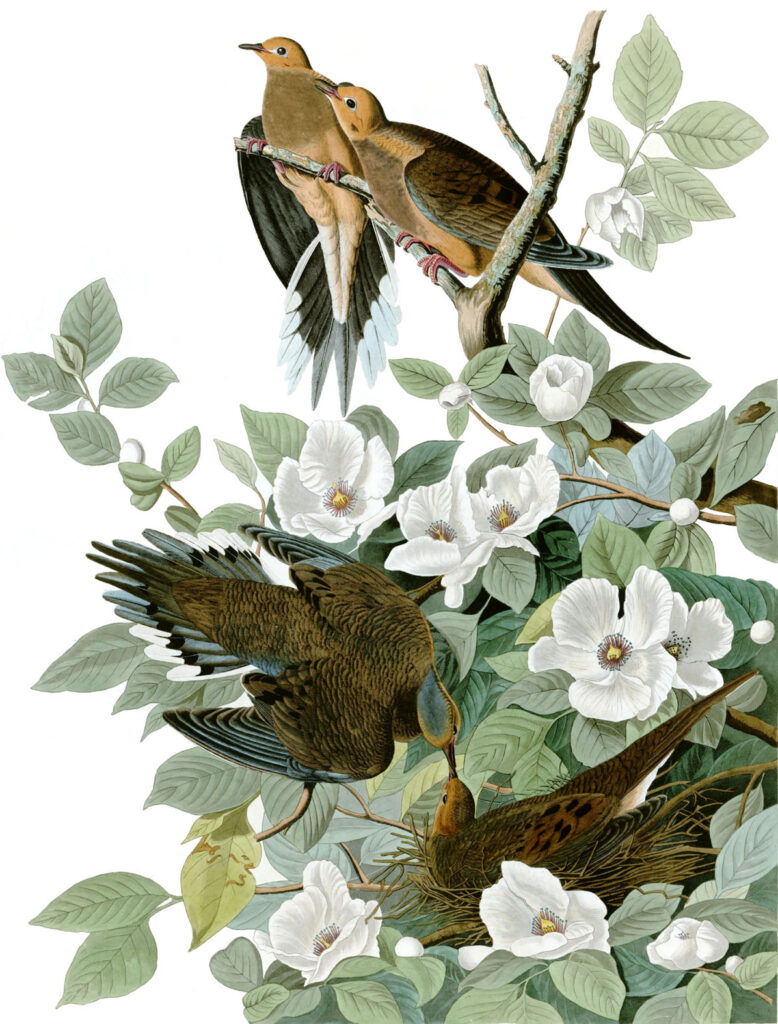
By James Audubon – Scan of modern reproduction of The Birds of America
(Edited and Color-corrected), Public Domain,
https://commons.wikimedia.org/w/index.php?curid=4953846
Needing water regularly, mourning doves frequently visit ponds, streams or birdbaths. Their ability to consume brackish water (more salty than fresh water, less salty than sea water) helps them exist in desert environments. Unlike most other birds which scoop water, mourning doves drink by sucking up the water with their beaks. Doves and pigeons — along with turkeys, chickens and quail — are the only birds able to drink via suction.
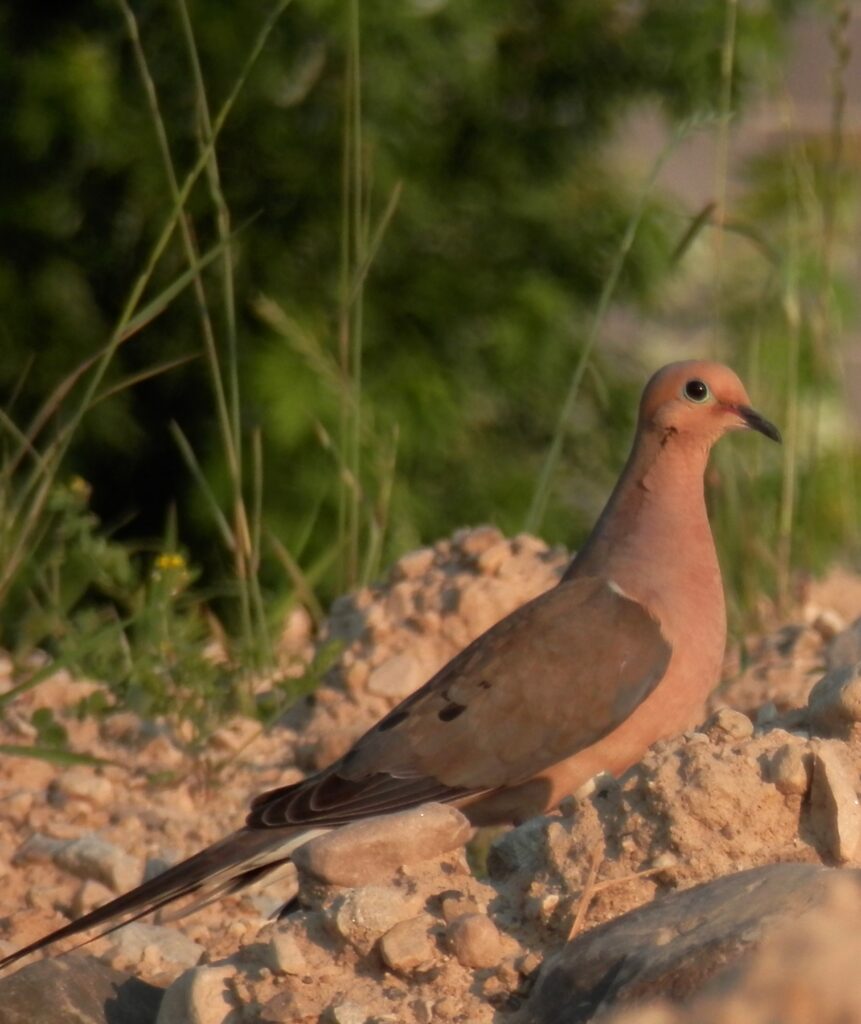
Photograph by Ryan Hodnett – Own work, CC BY-SA 4.0,
https://commons.wikimedia.org/w/index.php?curid=35966738
Folklore, Culture and Symbolism
Doves have a long history of symbolic significance for cultures and peoples all over the world. In numerous Native American traditions, mourning doves are revered for their spiritual and ecological roles, frequently associated with peace, love, hope, and rebirth.
One Huron/Wyandot legend tells of a maiden who loved and cared for mourning doves, which came to love her in turn. When she became sick and died
one day, the mourning doves tried to follow her to the spirit realm. Because they were still living, however, the doves could not enter the Underworld. At that moment they began a sorrowful cooing that continues even unto the present day and mourning dove its name.
The Blackfoot tribe associated the mourning dove with protection and safe return from battle. The bird’s feathers were often carried by war leaders as talismans to help them bring their warriors back safely.
Because its cooing cry sounds like their word for “acorn,” the Cherokee whimsically associate mourning doves with the strength and endurance of the oak tree.
Habitats and Habits
The mourning dove inhabits a variety of open and semi-open places such as farms, village greens, roadsides, grasslands and even deserts It tends to avoid dense forests and wetlands. While mostly preferring edge habitats with both trees and open ground, the mourning
dove is adaptable and tolerant of human disturbance. It can thrive in urban and suburban areas, and is a common sight in parks, gardens and backyards.
Mourning doves are social birds, and will often form large flocks, especially in winter. During the breeding season, one might see three Mourning Doves flying in tight formation, one after another in a form of social display. Typically the lead bird is the male of a mated pair. Following close behind is an unmated male chasing his rival from the area where he hopes to nest. Third in line is the female of the mated pair, which seems to go along for the ride. Perhaps she’s making sure these symbols of peace don’t get into a fight?
Welcoming Morning Doves to Your Yard
Popular with serious birdwatchers and backyard birders alike, the mourning dove is easy to attract and observe. Provide them with food, water and shelter and they’ll be visiting your yard in no time. The mourning dove prefers seeds of grasses, weeds, grains, and cultivated crops, such as corn, wheat, millet, and sunflower. Utilize a platform feeder, a tray feeder, or a ground feeder and fill it with their favorite seeds and grains. Birdbaths, fountains or shallow dishes of water provide a source of drinking and bathing water. Brush piles, shrubs and trees offer a place to roost and nest. And be sure to provide some cover and protection from hawks, owls, cats, and other predators.
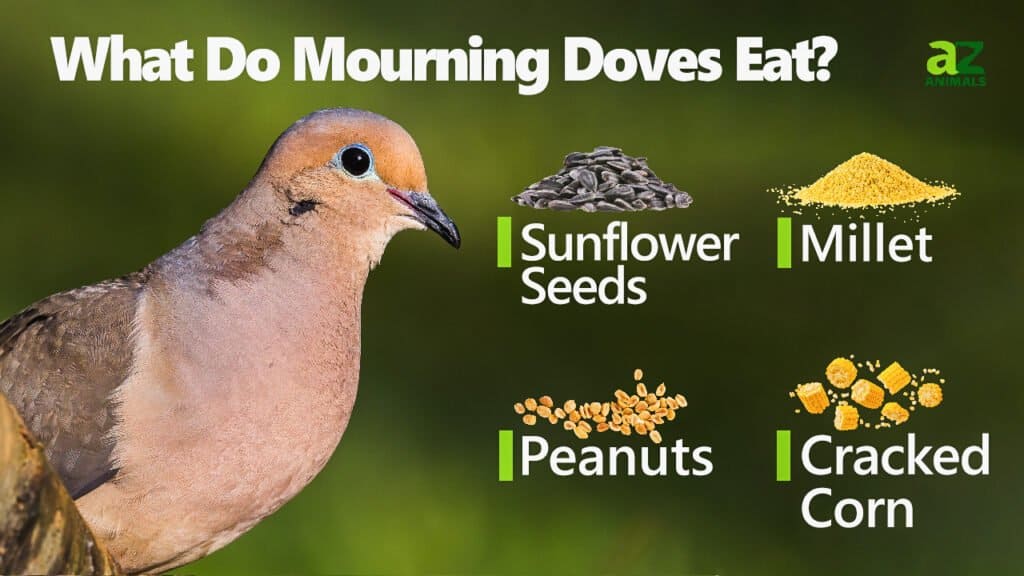
So there you have it. Almost all my life, I have considered the mourning dove to be a living treasure. Get to know these delightful birds and I think you’ll feel the same.
By Steven Roberts

